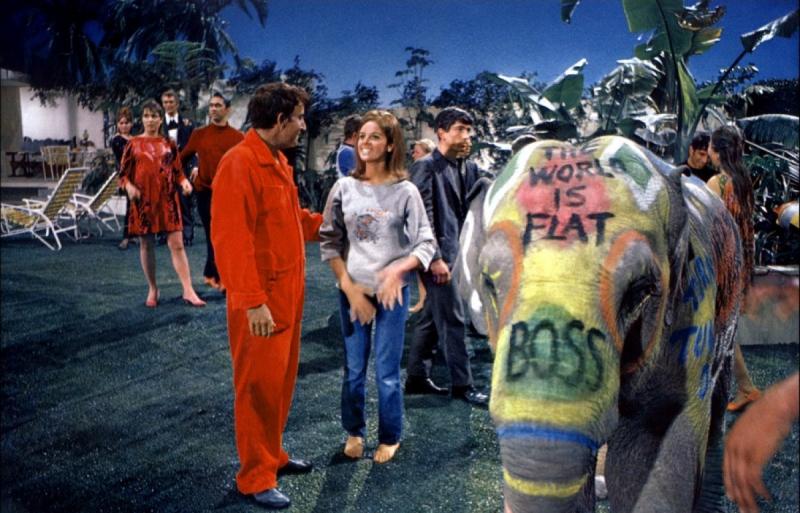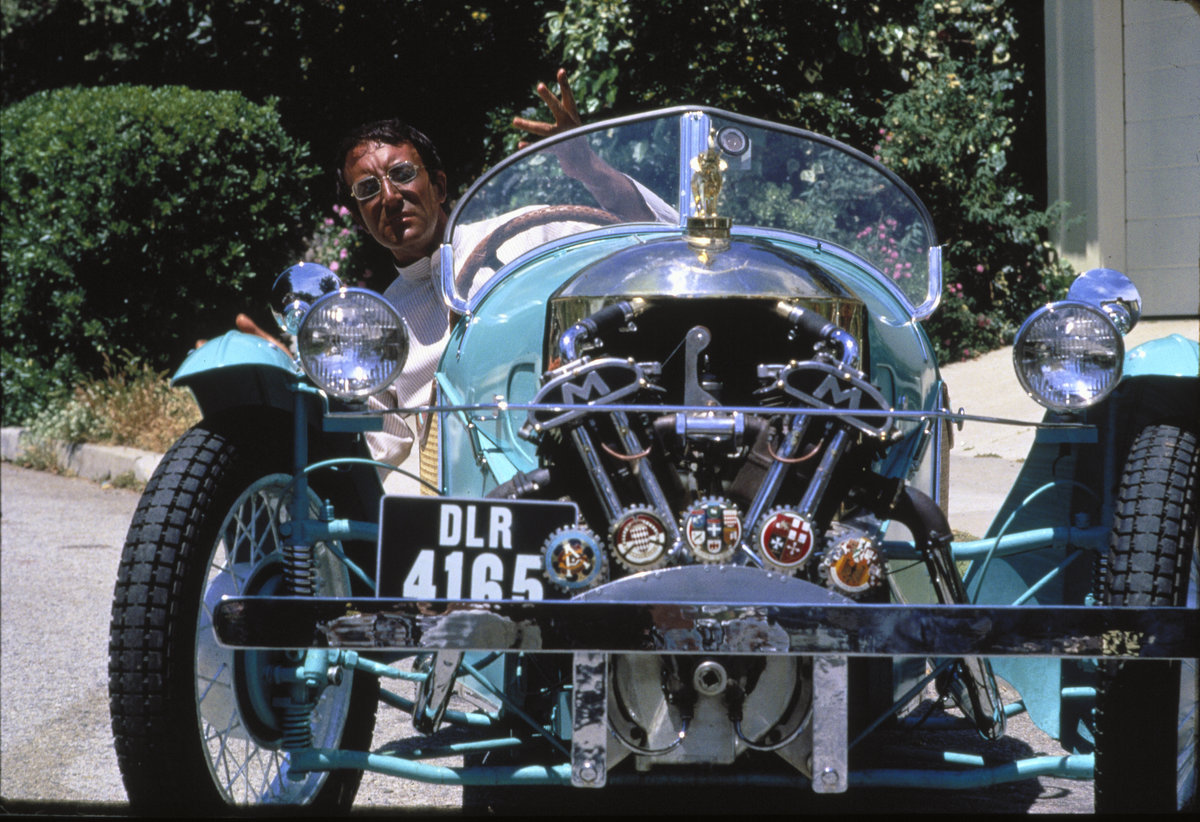Blu-ray: The Party | reviews, news & interviews
Blu-ray: The Party
Blu-ray: The Party
Blake Edwards and Peter Sellers on form in influential if excruciating 1960s comedy

There are two elephants in Blake Edwards’ 1968 comedy The Party. One appears literally at the film’s climax, emblazoned with graffiti. More significant, and troubling, is the metaphorical elephant in the room: that we’re invited to laugh at a white comedian in brownface.
Namely Peter Sellers, impersonating an Indian actor who unwittingly wrecks an upmarket Hollywood shindig. His Hrundi V Bakshi is almost a retread of the character he played opposite Sophia Loren in 1960’s The Millionairess. Still, according to a talking head interviewed in one of the bonus features, the film “was very popular in India”. Hmmm. Best just to accept that things were different then, and be glad that such antediluvian attitudes are mostly a thing of the past.
Edwards’ and Sellers’ key influence was surely Jacques Tati
This is a comedy of social embarrassment, about the agonies of not fitting in. A pre-credits sequence shows Bakshi unwittingly sabotaging a historical epic, wearing a modern wristwatch and later blowing up most of the set. Told that he’ll never work again, Bakshi’s name is accidentally added to the guest list of a party held by the studio head. That’s about it plotwise, the scenario allowing for a sequence of elaborate semi-improvised scenes.
Despite the inevitable reservations about Sellers’ accent and appearance, much of what follows is very, very funny: a series of immaculately choreographed mishaps involving footwear, birds, food, wigs and toilet paper. Edwards, reconciled with Sellers after falling out during the making of A Shot in the Dark, used a video camera to immediately review each take, allowing the set pieces to be polished to perfection. And there are some brilliant moments, from an attempt to retrieve a lost shoe to an iconic exchange with a parrot. Birdie num num, anybody? Edwards’ and Sellers’ key influence was surely Jacques Tati (though none of those interviewed in the bonus features admit this): Bakshi arrives at the party in a very Hulot-esque three-wheeler (pictured above), and the elaborate modernist set recalls Mon Oncle and Playtime. There are long stretches where Sellers’ character is on the periphery, and the sound mix often favours background noise over dialogue.
Edwards’ and Sellers’ key influence was surely Jacques Tati (though none of those interviewed in the bonus features admit this): Bakshi arrives at the party in a very Hulot-esque three-wheeler (pictured above), and the elaborate modernist set recalls Mon Oncle and Playtime. There are long stretches where Sellers’ character is on the periphery, and the sound mix often favours background noise over dialogue.
An elderly Edwards recalls that he’d originally wanted to make a film totally free of dialogue. It’s significant that The Party begins to unravel in its more conventional later stages, when Sellers begins to speak more and the semblance of a plot emerges. His Bakshi remains the most likeable character and duly gets the girl, blithely driving away from the party’s wreckage. Watch, and enjoy with a hefty dose of salt. Incidental pleasures include a cheesy Henry Mancini score (the title song featuring some excruciating Don Black lyrics), and the gloriously funky typeface used in the opening credits. The afore-mentioned bonus interviews suggest that all concerned had a groovy time making the film, and the restored image is vibrant.
Overleaf: watch the trailer for The Party
There are two elephants in Blake Edwards’ 1968 comedy The Party. One appears literally at the film’s climax, emblazoned with graffiti. More significant, and troubling, is the metaphorical elephant in the room: that we’re invited to laugh at a white comedian in brownface.
Namely Peter Sellers, impersonating an Indian actor who unwittingly wrecks an upmarket Hollywood shindig. His Hrundi V Bakshi is almost a retread of the character he played opposite Sophia Loren in 1960’s The Millionairess. Still, according to a talking head interviewed in one of the bonus features, the film “was very popular in India”. Hmmm. Best just to accept that things were different then, and be glad that such antediluvian attitudes are mostly a thing of the past.
Edwards’ and Sellers’ key influence was surely Jacques Tati
This is a comedy of social embarrassment, about the agonies of not fitting in. A pre-credits sequence shows Bakshi unwittingly sabotaging a historical epic, wearing a modern wristwatch and later blowing up most of the set. Told that he’ll never work again, Bakshi’s name is accidentally added to the guest list of a party held by the studio head. That’s about it plotwise, the scenario allowing for a sequence of elaborate semi-improvised scenes.
Despite the inevitable reservations about Sellers’ accent and appearance, much of what follows is very, very funny: a series of immaculately choreographed mishaps involving footwear, birds, food, wigs and toilet paper. Edwards, reconciled with Sellers after falling out during the making of A Shot in the Dark, used a video camera to immediately review each take, allowing the set pieces to be polished to perfection. And there are some brilliant moments, from an attempt to retrieve a lost shoe to an iconic exchange with a parrot. Birdie num num, anybody? Edwards’ and Sellers’ key influence was surely Jacques Tati (though none of those interviewed in the bonus features admit this): Bakshi arrives at the party in a very Hulot-esque three-wheeler (pictured above), and the elaborate modernist set recalls Mon Oncle and Playtime. There are long stretches where Sellers’ character is on the periphery, and the sound mix often favours background noise over dialogue.
Edwards’ and Sellers’ key influence was surely Jacques Tati (though none of those interviewed in the bonus features admit this): Bakshi arrives at the party in a very Hulot-esque three-wheeler (pictured above), and the elaborate modernist set recalls Mon Oncle and Playtime. There are long stretches where Sellers’ character is on the periphery, and the sound mix often favours background noise over dialogue.
An elderly Edwards recalls that he’d originally wanted to make a film totally free of dialogue. It’s significant that The Party begins to unravel in its more conventional later stages, when Sellers begins to speak more and the semblance of a plot emerges. His Bakshi remains the most likeable character and duly gets the girl, blithely driving away from the party’s wreckage. Watch, and enjoy with a hefty dose of salt. Incidental pleasures include a cheesy Henry Mancini score (the title song featuring some excruciating Don Black lyrics), and the gloriously funky typeface used in the opening credits. The afore-mentioned bonus interviews suggest that all concerned had a groovy time making the film, and the restored image is vibrant.
Overleaf: watch the trailer for The Party
rating
Share this article
The future of Arts Journalism
You can stop theartsdesk.com closing!
We urgently need financing to survive. Our fundraising drive has thus far raised £49,000 but we need to reach £100,000 or we will be forced to close. Please contribute here: https://gofund.me/c3f6033d
And if you can forward this information to anyone who might assist, we’d be grateful.

Subscribe to theartsdesk.com
Thank you for continuing to read our work on theartsdesk.com. For unlimited access to every article in its entirety, including our archive of more than 15,000 pieces, we're asking for £5 per month or £40 per year. We feel it's a very good deal, and hope you do too.
To take a subscription now simply click here.
And if you're looking for that extra gift for a friend or family member, why not treat them to a theartsdesk.com gift subscription?
more Film
 A House of Dynamite review - the final countdown
Kathryn Bigelow's cautionary tale sets the nuclear clock ticking again
A House of Dynamite review - the final countdown
Kathryn Bigelow's cautionary tale sets the nuclear clock ticking again
 theartsdesk Q&A: Idris Elba on playing a US President faced with a missile crisis in 'A House of Dynamite'
The star talks about Presidential decision-making when millions of lives are imperilled
theartsdesk Q&A: Idris Elba on playing a US President faced with a missile crisis in 'A House of Dynamite'
The star talks about Presidential decision-making when millions of lives are imperilled
 Urchin review - superb homeless drama
Frank Dillane gives a star-making turn in Harris Dickinson’s impressive directorial debut
Urchin review - superb homeless drama
Frank Dillane gives a star-making turn in Harris Dickinson’s impressive directorial debut
 Mr Blake at Your Service review - John Malkovich in unlikely role as an English butler
Weird comedy directed by novelist Gilles Legardinier
Mr Blake at Your Service review - John Malkovich in unlikely role as an English butler
Weird comedy directed by novelist Gilles Legardinier
 Don't Let's Go to the Dogs Tonight review - vivid adaptation of a memoir about a Rhodesian childhood
Embeth Davidtz delivers an impressive directing debut and an exceptional child star
Don't Let's Go to the Dogs Tonight review - vivid adaptation of a memoir about a Rhodesian childhood
Embeth Davidtz delivers an impressive directing debut and an exceptional child star
 One Battle After Another review - Paul Thomas Anderson satirises America's culture wars
Leonardo DiCaprio, Teyana Taylor, and Sean Penn star in a rollercoasting political thriller
One Battle After Another review - Paul Thomas Anderson satirises America's culture wars
Leonardo DiCaprio, Teyana Taylor, and Sean Penn star in a rollercoasting political thriller
 Steve review - educator in crisis
Cillian Murphy excels as a troubled headmaster working with delinquent boys
Steve review - educator in crisis
Cillian Murphy excels as a troubled headmaster working with delinquent boys
 Can I get a Witness? review - time to die before you get old
Ann Marie Fleming directs Sandra Oh in dystopian fantasy that fails to ignite
Can I get a Witness? review - time to die before you get old
Ann Marie Fleming directs Sandra Oh in dystopian fantasy that fails to ignite
 Happyend review - the kids are never alright
In this futuristic blackboard jungle everything is a bit too manicured
Happyend review - the kids are never alright
In this futuristic blackboard jungle everything is a bit too manicured
 Robert Redford (1936-2025)
The star was more admired within the screen trade than by the critics
Robert Redford (1936-2025)
The star was more admired within the screen trade than by the critics

Add comment